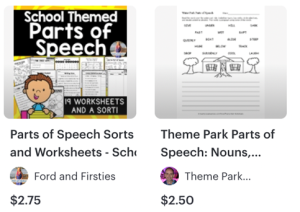Imagine this: it’s a Sunday night, and you’re buried under a mountain of unmarked books, lesson plans to be finalised, and coffee mugs that have seen better days. Or, perhaps, it’s a Tuesday morning. Your alarm didn’t go off so you’re late to work. When you’re finally in your classroom, you realise you don’t have a worksheet for today’s lesson on fractions. And it’s first period. And the bell’s just gone…
Every teacher experiences these moments and, as a result of an overstretched schedule or a bout of End-of-Term-itis, many teachers turn to TES or Teachers Pay Teachers (TPT) for a ready-made worksheet rather than spending time making their own. Whilst this is a reality for many of us, there is a growing group of educators who are learning how to profit from this daily occurrence. Because, after all, it’s no secret that teaching is a labour of love, but it’d be nice if that love could, you know… pay the bills.
It’s not a pipe dream, and it really isn’t as labour intensive as you might imagine; it’s a reality where you, the teacher, can make money from things you have already created, and these classroom creations can earn you some serious moolah.
What are all these acronyms… TPT? TES?
TPT and TES are two of the most lucrative online marketplaces for teaching resources. Think of them as an Etsy but for teaching slides, worksheets, educational games or even classroom décor. TPT caters to a more American/International audience, with products predominantly being sold in Dollars and using American spellings, and TES is more focused on the British market. From my personal experience, getting started on TPT gives you better chances of making money (over 300 people have become millionaires from their TPT stores…), especially as TES is in direct competition with the behemoth that is Twinkl, but there is a lot more competition there, so the key thing for you to do is…
Know your Niche!
Whether you’re an EYFS Teacher, a Senior Cover Supervisor or a Key Stage 2 All-Rounder, the first thing you need to do is identify what your speciality is, and where the gaps in the market are. For example, when I first started selling resources, I had great ambitions of appealing to all avenues of teachers, posting one or two resources for every subject. I thought that if I kept my focus broad that I had the best chances of making sales; however, I quickly found that my extremely niche Japanese resources sold like hot-cakes, as did my English text-based units for books tied to Literacy Evolve or Cornerstones topics. Finding your niche will help you create a brand and appeal to a specific audience, but the most important thing to remember is that your resources are there to…
Make a Fellow Educator’s Life Easier
The products that often make the most sales are the ones that are annoying or time-consuming to create. This can be frustrating to us as sellers, but it’s all worth it when the sales start rolling in. Think about it- if a potential customer could make a worksheet themselves in five minutes, why would they bother spending money on buying one? A good example of this would be addition or subtraction worksheets. Thousands of these already exist for free, so it may not be the best first product to upload.
However, when I taught Key Stage 2 maths, there was no way I’d bother spending my precious out-of-work hours drawing 35 different arms on clock faces for children to learn to tell the time to the nearest minute. Often, ‘Time’, ‘Fractions’ and ‘Shape/Angles’ are the best maths topics to create resources for. This can be a helpful headspace for you to lock into when thinking about what it is you’d like to sell- would you buy this? Does your product…
Catch the Eye of the Customer
Once you’ve decided on which website to sell on, and which niche to burrow into, the last piece of the puzzle is learning how to market your resources. As TPT and TES have been growing in popularity (especially since lockdown-teaching during COVID), the competition has been getting steeper. One way to ensure that you’re standing out amongst the other items for sale is by ensuring you include attractive thumbnails or previews of what customers will actually receive with their purchase.
Much like judging book covers before buying, customers are looking for products that look appealing (think bright colours, clip art and easy-to-read titles). For example, let’s search for a worksheet on word class (or ‘parts of speech’ to the American market).

If you look at these two resources that pop up side-by-side in the search results, one looks polished, professional and branded, whereas the other is a simple screen shot of the worksheet- much less likely to gain attention from the rushed and over-worked teacher customer! Lots of people make their thumbnails for products on PowerPoint or Canva, and they take fewer than five minutes to make.
As a rule, you should ensure that you include:
– A large title that can be seen when the thumbnail is a tiny square in the search results
– A related picture to bring it to life
– Screenshots of the products
– A smaller text box that mentions specifics
Get That Ball Rolling
Okay, so you’ve polished your resources, and now it’s time to make some real money. Getting set up on TES or TPT is a quick and easy feat:
1. Register and Set Up Shop
The first step is to sign up as a seller. You’ll need to provide some basic information in order to set up your shop. Remember, your shop’s name and branding are your first impressions – make ’em count!
2. Upload Your Resources
Time to show the world what you’ve got! Upload your teaching resources, add catchy titles and descriptions, and don’t forget to include some snazzy preview images. Take a look at three high earners on TPT for some ideas: Deanna Jump, Michelle Griffo, Hello Literacy. Before bunging anything online, though, always make sure you’re doing so legally… always respect copyright laws and give credit where it’s due!
3. Pricing Strategies
Now comes the fun part: pricing. You can offer your resources for free or set a price, but it’s important to shop around and see what others are selling similar items for. Make sure you’re not selling your hours of work for pennies!
4. Bundle, Bundle, Bundle!
When I first started during lockdown, I went deep into the annals of the TPT forums to try and work out how best to make my store successful. The number one piece of advice that everybody gave to me was that creating bundles of similar products is the best way to make money. I doubted this- higher price bundles surely were less popular than the $1 worksheets that people would think nothing about purchasing, no?
No.
I was wrong.
My highest price item on my store (12-week Japanese course for $70) is also my most popular… go figure!
Is It Worth It?
As educators, we’re already strapped for time, so investing precious hours into opening a store can feel a little demoralising- especially if you don’t immediately make $384,297 in your first month on the sites. However, hearing the ‘cha-ching!’ sound that comes from each sale on the TpT app (Google Play Store, iOS App Store) is definitely worth it, at least for me. Once you’ve put those hours in, the work is over and you can find yourself earning money passively whilst making dinner, sleeping or even sat on the toilet (speaking from personal experience, that’s always the best!). Not only this, but looking at the data on your Author Dashboard and seeing all of the different countries that your resources are being used in gives a real sense of achievement and pride.
In conclusion, despite the seemingly steep learning curve and the initial time investment, I wholeheartedly recommend venturing into the world of resource selling. It’s an exceptional way to breathe new life into those old teaching materials that may be gathering digital dust. Who knows – you could be the next “teacherpreneur,” earning more from digital downloads than from traditional teaching or supply work.
And if you’re on the hunt for ideas to kickstart your resource-selling journey, feel free to dive into last month’s blog, where we explored the role of AI in creating teaching resources. Combining these two avenues can kickstart your teaching resource empire. So, embrace the opportunity to turn your passion into profit – because in the realm of education, your love for teaching can indeed balance those financial scales.
Next month, we’ll be (tentatively) getting a little festive and looking ahead to the Christmas count-down in the classroom- specifically, how to stay on top of behaviour management and stay sane as the nights get longer. I’ll also be offering some Christmas-themed freebies to help you with those early-finishers, whether in your own classroom or whilst covering an unruly class on supply!
Lauren Austin 🍎🍂



